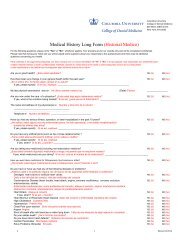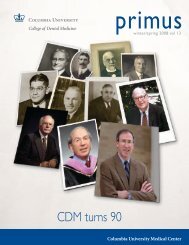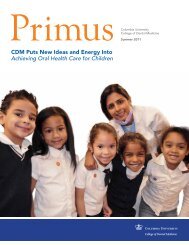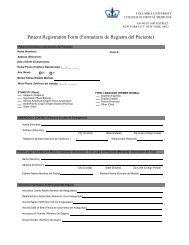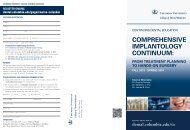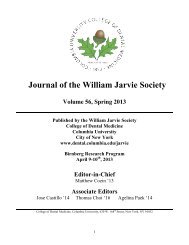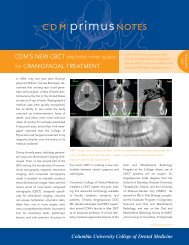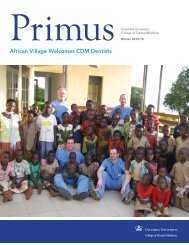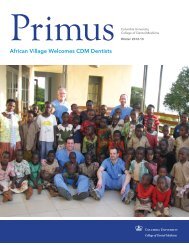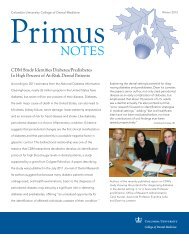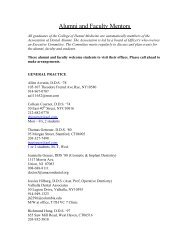Fall 2006 - College of Dental Medicine - Columbia University
Fall 2006 - College of Dental Medicine - Columbia University
Fall 2006 - College of Dental Medicine - Columbia University
You also want an ePaper? Increase the reach of your titles
YUMPU automatically turns print PDFs into web optimized ePapers that Google loves.
meeting <strong>of</strong> Oral and Maxill<strong>of</strong>acial Surgeons.Researchers exploring the pathogenesis <strong>of</strong> TMDover the past decade had already identified somekey immunological regulators. But, by using whatthey believed to be more appropriate controls,Drs. Chang and Israel were seeking to demonstratea clearer distinction between disease andhealth in the temporomandibular joint than hadbeen shown previously.Twenty TMD patients with “severe pain and limitation<strong>of</strong> mandibular movement that had failed toimprove with at least three months <strong>of</strong> a full course<strong>of</strong> nonsurgical therapy” and 13 members <strong>of</strong> a controlgroup were examined arthroscopically forsigns <strong>of</strong> osteoarthritis, synovitis, internal derangement,disc perforation, or adhesions. Next, theresearchers analyzed the level <strong>of</strong> three specificinflammatory mediators in lavage samples fromthe temporomandibular joint synovial fluid <strong>of</strong> bothpatient and control groups. Their work revealedthat degenerative conditions found in the TMJs <strong>of</strong>symptomatic subjects were “almost always”accompanied by significantly elevated levels <strong>of</strong> synovialinflammation, which can cause destruction tothe joint tissues by stimulating inflammatory activitythat has the potential to damage the articulardisc surface. Earlier research had tended to sidestepbiochemical and tissue changes that may precedecartilage destruction in the joint space.Not only did their results help to clarify the pathogenicmechanisms <strong>of</strong> TMDs in patients with severesymptoms, but the authors also point out that themethodology used in the study could lead to beneficialresults for TMD patients. They concludedthat, “Lavage <strong>of</strong> the joint space via arthrocentesisassists in the removal <strong>of</strong> inflammatory mediatorsand antigenic sources. Arthroscopic surgery alsoprovides lavage <strong>of</strong> the joint space while enablingdirect visualization and treatment <strong>of</strong> inflamed synovialtissues, osteoarthritic cartilaginous tissues, thephysical removal <strong>of</strong> adhesions and mobilization <strong>of</strong>the articular disc. The end result <strong>of</strong> a successfularthroscopic surgery is a joint with reduced inflammatorymediators and a reduction <strong>of</strong> cartilagebreakdown products in the synovial fluid. Thisleads to a decrease in antigen load and a decreasein inflammation, which ultimately results inimproved maximum opening distance and reducedjoint pain.”Dr. Chang has also explored pharmacologicaltreatment for TMD. Writing in the December2005 issue <strong>of</strong> Dentistry Today, she discusses botulismtoxin (BTX) use for this purpose. A blocker <strong>of</strong>neuromuscular transmission, BTX received FDAapproval in the 1980s for use in cases <strong>of</strong> focal dystonias.Subsequently, BTX has found medical applicationin many areas, including subcategories <strong>of</strong>TMD, like bruxism, clenching, masseteric hypertrophy,recurrent dislocation, oromandibular dystonia,and my<strong>of</strong>acial pain. Dr. Chang summarizes studiesthat show a growing body <strong>of</strong> evidence for successin treating these TMJ problems with BTX, althoughshe adds that there have been some reports <strong>of</strong> difficultyin swallowing, which could lead to moreserious problems. In closing, she points out thatthe effects <strong>of</strong> the treatment are reversible and itsadministration is minimally invasive.Whether through elucidating the causes <strong>of</strong> TMD atthe cellular level, or determining the best course <strong>of</strong>treatment to give them relief, Dr. Chang’s focus ison helping her patients. Her attitude is made clearin the New York Times article, which quotes her assaying, “...if someone comes to you with pain, theyhave pain. I don’t give patients the runaround andsay it is imaginary.”Dr. Chang in her <strong>of</strong>fice in the Division <strong>of</strong> Oraland Maxill<strong>of</strong>acial Surgery at CDM.14primus<strong>2006</strong>



